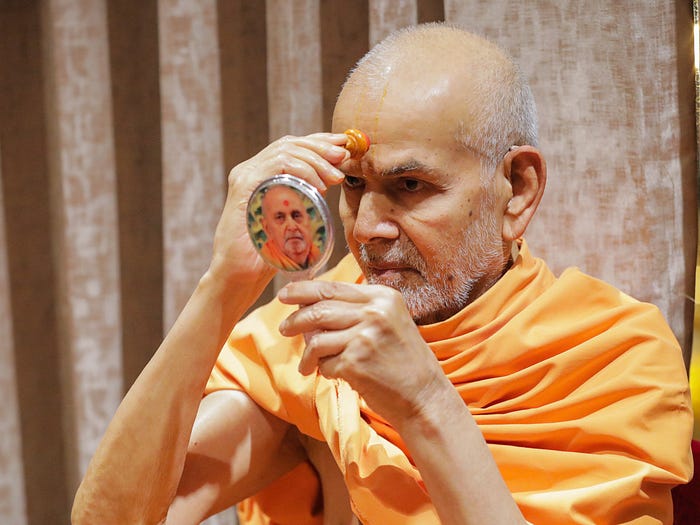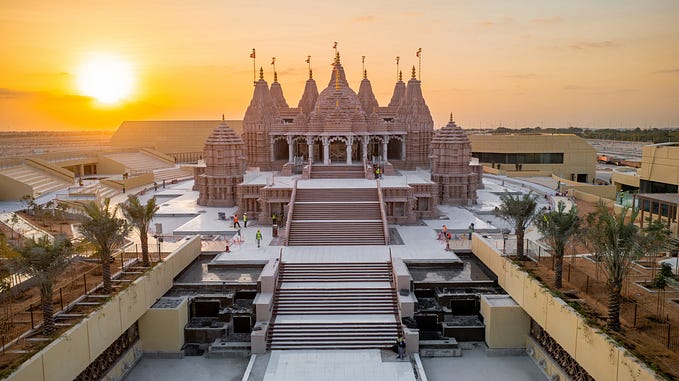My Tilak-Chandlo
“What is that symbol on your forehead?”
As I was leaving Follinger Auditorium — a large auditorium at the University of Illinois — I head someone yell from the crowd of students.
“Hey! Wait up!”
I turned around to see a student catch up to me. “Jay Swaminarayan,” he said.
“umm… Jay Swaminarayan,” I replied, not knowing who he is.
He went on to say that he saw my tilak-chandlo and knew that I was part of the Swaminarayan fellowship. We then had a conversation as we walked towards the Business Instruction Facility and still stay in contact to this day.

This is not the first time that I’ve been noticed for wearing a tilak-chandlo. There have been many instances while on campus at the University of Illinois where my tilak-chandlo has allowed me to meet so many different people — from students who did not know there are students of the Swaminarayan tradition to administrators asking about various Hindu festivals.
This article is split into 3 main sections:
- What is a tilak-chandlo?
- What is the history of the Swaminarayan tilak-chandlo?
- What does the tilak-chandlo signify?
Tilak, Bindi, Vibhuti, Tikka… What is it?
Just as Christians may wear ash on Ash Wednesday or a cross around their neck, or Muslim women may wear a hijab, Jews may wear a kippah or tzitzit…
Similarly for Hindus, it is applying a powder or paste on one’s forehead, known by multiple names based on the shape and application purpose. Some of these words include bindi, tilak/tikka, vibhuti, chandlo, bhasma, etc.
For example, many Vaishnavs put the urdhva pundra, or a pattern in the shapre of a ‘U’ (which the Swaminarayan tilak-chandlo is derived from). It is not mandatory for a Hindu to wear a tilak/bindi as it is based on individual and regional traditions as well as the purpose of application.

Applying the tilak-chandlo between the eyebrows on the forehead is associated with the ājñā chakra, which signifies the subconscious mind. It is also where the frontal lobe lies on the brain, which is responsible for higher cognition function. Applying the tilak-chandlo here allows one to pay reverence to it to ask God to give one proper intelligence.
What is a Tilak-Chandlo?
A tilak-chandlo, or chandlo, is a marking of the Swaminarayan fellowship.
The tilak represents the charanavind (or holy lotus feet) of God.
The chandlo represents the bowed head of a devotee of God.

Male aspirants apply a U-shaped tilak of sandalwood paste and a chandlo of red saffron powder on their forehead.
Female aspirants apply a chandlo of red saffron powder on their foreheads, also known as a bindi.
Bhagwan Swaminarayan has provided guidance on this specific shape in the Shikshapati (a scripture on the code of conduct for aspirants of the Swaminarayan fellowship):
“All male followers shall mark their forehead with an Urdhvapundra (U-shaped) Tilak with a round mark of Kumkum at the centre of it. All married women shall make only a round mark of Kumkum on their foreheads.”The importance of applying the tilak-chandlo or chandlo during one’s daily morning puja is noted in the Satsang Diksha (a key scripture within the Akshar-Purushottam Darshan within the Swaminarayan fellowship that concisely explains the teachings of Bhagwan Swaminarayan):
प्रभुपूजोपयुक्तेन चन्दनेनोर्ध्वपुण्ड्रकम्।
भाले हि तिलकं कुर्यात् कुङ्कुमेन च चन्द्रकम्॥५३॥
उरसि हस्तयोश्चन्द्रं तिलकं चन्दनेन च।
स्वामिनारायणं मन्त्रं जपन् कुर्याद् गुरुं स्मरन्॥५४॥“While chanting the Swaminarayan mantra and remembering the guru, apply a U-shaped tilak made from chandan that has been sanctified by having been offered to Bhagwan and a kumkum chandlo to the forehead. One should also apply a tilak-chandlo of chandan to the chest and both arms.” (Satsang Diksha verses 53–54)केवलं चन्द्रकः स्त्रीभिः कर्तव्यस्तिलकं नहि।
कुङ्कुमद्रव्यतो भाले स्मरन्तीभिर्हरिं गुरुम्॥५५॥“While remembering Bhagwan and the guru, women should imprint only a kumkum chandlo to their foreheads. They should not apply a tilak.” (Satsang Diksha verse 55)
A question some of you may be wondering is why is there a difference between a tilak-chandlo and chandlo for men and women?
To be quite frank, it is agna, or the commands of God and the ideal guru which one follows if one accepts the fellowship.
However, if you really need an explanation, here is one: Vermillion, or kumkum, is a symbol of Lakshmiji, the goddess of prosperity and Radhaji, an incarnation of Lakshmiji and a symbol of love and devotion.
How Did the Tilak-Chandlo Become Associated With the Swaminarayan Fellowship?
On February, 13, 1821, Bhagwan Swaminarayan was in the village of Panchala, Gujarat to celebrate the Holi festival. He gave the sadhus (Hindu monks) a small piece of sandalwood and instructed them to all do a tilak for the next day.
The next morning, Bhagwan Swaminarayan did not see a tilak on any sadhus foreheads. After further inquiry, he found out that the sadhus ate the sandalwood, thinking that it was prasad (sanctified food)! He distributed another piece and instructed them to perform a tilak.
The next day, he saw that all the sadhus had applied tilaks of different shapes and sizes.

Bhagwan Swaminarayan took the matter into his own hands and requested Gunatitanand Swami to come forward. With his own hands, Bhagwan Swaminarayan applied a sandalwood tilak and a round chandlo of kumkum on the forehead of Gunatitanand Swami.
Showing the tilak-chandlo to all, Bhagwan Swaminarayan stated, “This is our tilak. No God can compare with me and no sadhu can compare with this sadhu (Gunatitanand Swami).”
Bhagwan Swaminarayan himself has standardized the tilak-chandlo for all of the Swaminarayan fellowship.
What Does the Tilak-Chandlo Signify?
The tilak-chandlo signifies many principles of the Swaminarayan fellowship. Below are three levels of understanding that the tilak-chandlo can signify.

#1 Complete Refuge in God
The first representation of the tilak-chandlo is reminding oneself of one’s refuge in God.
A spiritual aspirant who seeks moksha (liberation) from the cycles of births and deaths seeks refuge in one’s ishtadev (a predominant deity that one seeks refuge in).
By seeking refuge at the feet of one’s ishtadev, one accepts to serve one’s ishtadev. It can be said that the spiritual aspirant has become a servant of their ishtadev, serving one’s ishtadev through every action.
The round shape of the chandlo represents that every single action of the aspirant should be God-centric. All thoughts, actions and words should align with the wish of God. Being in the center of the tilak allows one to remain at the feet of God and remind oneself that they are in the service of God.
The tilak-chandlo represents one’s surrenderance to God, being a humble servant at God’s feet.

#2 Relationship Between the Ideal Devotee & God
The second representation of the tilak-chandlo is of the relationship between the ideal bhakta (disciple) and Bhagwan (God).
The relationship between the ideal devotee and God is a fundamental relationship in Hinduism. The ideal disciple shows all aspirants how one should offer perfect devotion to God.
Bhagwan Swaminarayan explains this concept numerous times in the Vachanamrut (a scripture noting his discourses), specifically Vachanamrut Vadtal-5 where he notes how one should offer similar service to the ideal bhakta (disciple) as one would offer to God.
There are numerous examples of the bhakta-Bhagwan relationship that are forever immortalized in Hinduism:
- Radhikaji, next to Shri Krishna Bhagwan
- Sitaji, next to Shri Ram Bhagwan
- Hanumanji, next to Shri Ram Bhagwan
- Nar, next to Shri Narayan Bhagwan
- Parvatiji, next to Shri Shiv Bhagwan

Bhagwan Swaminarayan himself applied the tilak-chandlo for the first-time on the forehead of his senior sadhus, Gunatitanand Swami. In one of the traditions of the Swaminarayan fellowship, it is a fundamental principle that Gunatitanand Swami was not only a senior sadhu, but Bhagwan Swaminarayan’s ideal disciple.
In the theological and philosophical traditional established by Bhagwan Swaminarayan and propagated by Sadhu Yagnapurushdasji (Shastriji Maharaj), known as the Akshar-Purushottam Darshan, it is Gunatitanand Swami who is the ideal bhakta of Bhagwan Swaminarayan.
This pair is known as Shri Akshar-Purushottam Maharaj.
In this way, the chandlo represents the ideal bhakta bowing down to God’s feet, represented by the tilak.
It is a eternal symbol of how one should look up to the bhakta, or ideal disciple of God, to perform perfect worship of Bhagwan, or God himself.

#3 Aksharam Aham Purushottama Dãso’smi
The third and most revered representation of the tilak chandlo is the sadhana (spiritual endeavor) and siddhi (goal) of the Vedanta tradition established by Bhagwan Swaminarayan, known as the Akshar-Purushottam Darshan.
The praxis of the Akshar-Purushottam Darshan can be summarized in a simple 4-word Sanskrit mantra:
Aksharam aham Purushottama dãso’smi“Being Akshar, I am Purushottam’s servant.”
Within the Akshar-Purushottam Darshan, the spiritual endeavour and goal is the same two-fold principle:
- To attain oneness with Aksharbrahman/Akshar (understanding this to be attaining the divine qualities of Aksharbrahman and achieve the highest spiritual state), and
- To become Parabrahman/Purushottam’s servant (or to humbly follow God’s commands and worship God).
Hence, the chandlo represents “Aksharam aham,” signifying the goal of attaining oneness of one’s atma (the true-conscious-blissful soul) with Aksharbrahman and attaining the highest spiritual state for a jiva.
The tilak represents “Purushottam daso’smi,” literally signifying being a humble servant of Purushottam by serving the feet of Purushottam. Being a servant is to be humbly follow the commands of Purushottam.
The tilak-chandlo is a daily reminder to all spiritual aspirants of the foundational principle of the Akshar-Purushottam Darshan, of one’s endeavor to developing oneness with Akshar and developing a bond with Purushottam (God) as a humble servant.
But why wear it?

Pramukh Swami Maharaj asked him, “What problem do you have? If someone is preventing you [to wear the tilak-chandlo], let’s discuss with him…”
“No, no. Its not like that,” said Sandeep. “I myself feel it is best to do the tilak-chandlo only when I have improved my life by living according to niyam-dharma (the codes of conduct of the tradition)”.
Pramukh Swami Maharaj replied, “Your life will become ordered when you start applying the tilak-chandlo. Once you start you will gain the mental strength to continue.”

To many who may see my tilak-chandlo as just a symbol, I see it as a reminder of my belief system and practices.
By no means am I perfect. There are many instances in a single day where I may not follow my own value system, but that does not mean I do not try to make an effort to better myself.
This tilak-chandlo not only helps me better understand and follow my belief system, but also allows me to engage in a discussion with people of various backgrounds to better understand what composes of our individual identity.
A tilak-chandlo, or bindi/vibhuti/tikka/whatever you may call it, is a symbol of the values of Sanatan Dharma (aka Hinduism). Although it may look like a symbol symbol that one applies to their body, it has a depth in its meaning.
It is important that as Hindus, and any religious individuals, to understand their religious symbols and traditions. It is vital now, more than ever, to better understand our stories, traditions and belief systems and share these values with the world.
On the occasion of World Bindi Day and Hindu Heritage Month, I humbly encourage all to take a step towards the duality of learning about their own faith’s traditions, stories and beliefs and respectfully learning on other traditions.
This article was written on the occasion of World Bindi Day and Hindu Heritage Month. #worldbindiday #missionbindi #bindipride
Note: Sources and research are linked within the quotes or the analysis itself. Highly encourage all to use these resources to their advantage.








